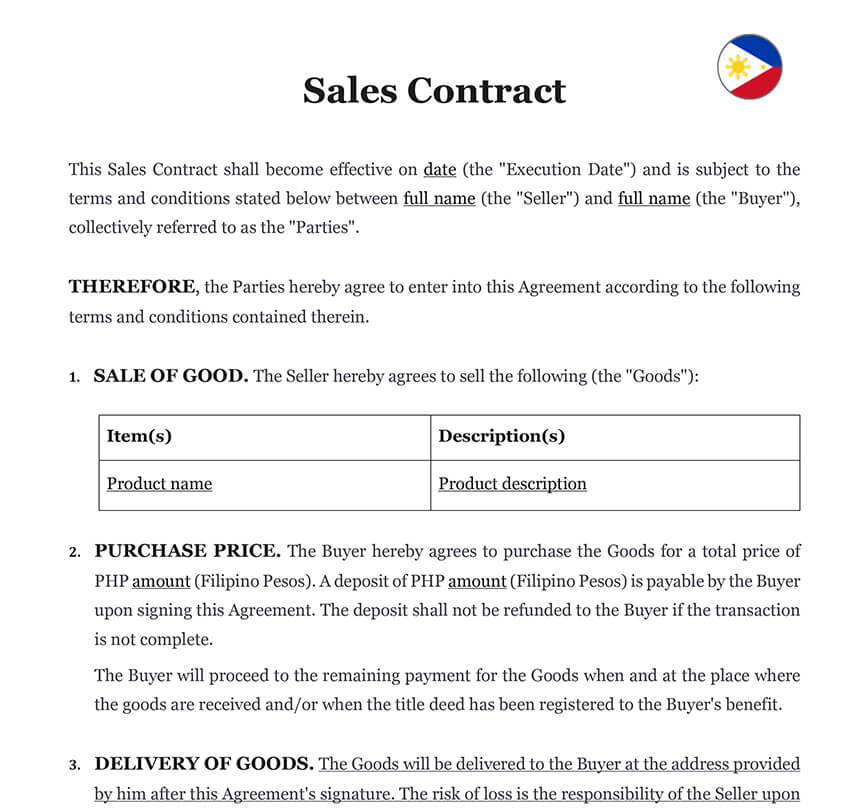Ready to use legal template
Drafted by experienced lawyers
Compliant with Filipino law
Ready to use legal template
Drafted by lawyers
Compliant with Filipino law
Home › Business contracts › Sales contract
Learn more about Sales Contract in Philippines
A Sales Contract is a legally binding agreement between a buyer and a seller outlining the terms and conditions of a sale of goods or property. In the Philippines, a well-drafted Sales Contract is essential for protecting both parties’ rights and ensuring that the transaction proceeds smoothly. It sets out clear details such as the purchase price, payment terms, delivery timelines, product specifications, and remedies in case of breach or non-performance. This document is especially important for business owners, entrepreneurs, and individuals entering into sales transactions, as it helps prevent disputes and provides legal clarity in line with Philippine civil and commercial laws. Download our Sales Contract drafted by our legal experts, easy to edit in Word format and tailored for use in the Philippines.
Table of contents
What is a Sales Agreement?
A contract of sale is defined in the Philippines’ New Civil Code as a contract in which one of the contractual parties agrees to transfer ownership of and deliver a specific item in exchange for a certain sum of money or its equivalent. According to the aforementioned definition, a contract of sale is by definition a consensual contract because it is perfected by mere assent.
Furthermore, in all sales transactions, the seller is required to furnish information. Before the transaction, the buyer must understand all of the contract’s provisions. The vendor is also required to guarantee the customer against concealed faults and to provide an item that meets the agreed-upon specifications. Finally, he is accountable for the object’s safety and is liable in the event of damage. With a restriction of liability provision, he cannot be discharged from his responsibilities due to the product’s flaw.
What is included in a Sales Contract?
Regardless of the goods or services being sold, there are five critical factors that are vital to moving negotiations ahead swiftly and preventing complications with the transaction down the road when writing a sales contract (sales agreement, purchase agreement, etc.). Each of these factors establishes expectations, and meeting those expectations contributes significantly to repeat sales and long-term, mutually productive commercial partnerships.
1. Product Description
Nothing kills a transaction faster than receiving a yes for one thing and then having the incorrect numbers or things in the contract. With so much possibility for inaccuracy, the description of items is sometimes regarded as the most crucial phrase. Include all pertinent information about the specific items the customer want to acquire, such as kind, model number, weight, color, size, number of seats, term length, plan, and so on.
2. Instructions for Delivery
Be specific about the time and date of delivery, the delivery location, and who is liable for the risk of products loss while in transit. In the case of SaaS, this would include deployment and onboarding.
3. Period of Inspection
The inspection period allows the buyer to check the products after they have been delivered and reject any nonconforming goods. The inspection time might vary widely depending on the items involved, but adding this in sales contracts can go a long way toward fostering loyalty that leads to renewals and repeat purchases. POCs and trials are two further examples.
4. Guarantees and Warranties
The Sales Contract should incorporate any commitments made during the selling process. Because goods and services offered differ from industry to industry and firm to company, there is no “standard warranty” knowledge that can be assumed on either end. To appropriately set expectations for the future, be explicit about the warranties included, if any.
5. Payment Information
It’s a no-brainer to include the price. But what about the other payment terms and conditions? Is payment expected in installments or in one big sum? Were any arrangements established to finalize the deal, such as a payment deadline, quarterly vs annual billing, or other agreements? Are there any unique considerations for a particular market?
Forgetting to submit the relevant payment data is like to going to the beach and forgetting to bring your suits. You can swim nude, but you risk being burned. It is preferable to be thorough and avoid the danger.
Why do you need a Sales Agreement?
In general, the agreement to sell might be tacit, or oral: there is no legal duty if the contract of sale is not in writing. Certain types of property, on the other hand, must be the subject of a written contract of sale, sealed by an authentic act, i.e. accepted and drawn up by a notary. This is true, for example, of real estate transactions.
In the event of a disagreement, the contract serves as proof: for important transactions, especially between experts, it is best to establish one’s agreement through a contract of sale to better safeguard the transaction.
Despite the fact that in commercial situations, the means of proof is free. A formal Sales Contract stating the sum to be paid, the good(s) sold, and the consent of the lawyer makes it much easier to establish the transaction (by means of his signature).
Furthermore, if the parties wish to include specific clauses not permitted by law (reservation of ownership, delivery at the seller’s expense, payment of the price in installments, etc.), the written Sales Contract allows them to demonstrate that the signatories accepted the general terms of the sale.
How to draft a written Sales Agreement?
The following are the stages to creating a sales contract:
| ➤ Use strong characters to write the phrase "sales contract" towards the top of your page. This adequately describes the instrument and establishes that it is a legally enforceable contract. |
| ➤ Outline the activities of all parties engaged in the opening paragraph. Indicate that you will be the vendor and the other party will be the buyer. Include the dates of this section's selling so that it is clear when the contract was written. Include your address as well as the addresses of any customers indicated in this contract. |
| ➤ In the next part, accurately define your product or service that will be offered to the buyer. List the dates on which the buyer will get the product or service. |
| ➤ In the next section, provide all payment terms from the buyer. Take note of the total cost of your goods or service, as well as whether payment will be paid all at once or in installments. Highlight each payment deadline and the sorts of payments that you accept. |
| ➤ In the next section, list any penalties in place if the products and services are not paid according to the contract. |
| ➤ List all late fees, when they apply, and when you anticipate them to be paid. List any requirements, if any, for the customer to be able to reject the products or services. This might involve buyer unhappiness. Include a time frame during which the customer must declare that he or she is dissatisfied in order to reject the product or service. |
| ➤ Make a note of the date the agreement was signed towards the bottom of the contract. Sign the agreement with all parties. |




